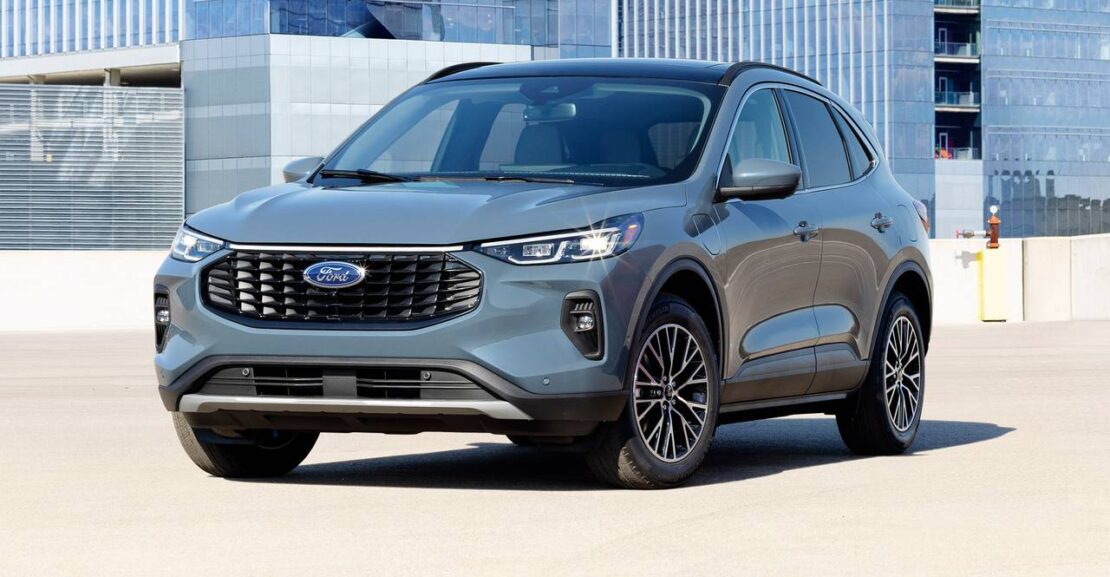The 2025 Ford Escape has several changes and updates from the previous model year. Although it’s not a significant refresh year like 2023, Ford has introduced some notable tweaks for 2025 that buyers should be aware of. If you’ve been considering the 2024 model, it’s worth noting the differences in the 2025 version before deciding.
Table of Contents
Critical Updates for the 2025 Ford Escape:
– Price Drop: The 2025 Ford Escape starts at $27,995, a significant reduction from the 2024 model year’s $29,495. This price drop comes with some trade-offs, including fewer features.
– Removed Features: Some features have been eliminated, such as rain-sensing wipers, ambient lighting, and the Active Park Assist 2.0. Several dealer-installed options, like the smoker’s package and more prominent cargo organizer, have also been discontinued.
– New Color Options: The 2025 Escape introduces a new Space Silver Metallic color, while Iconic Silver and Race Red have been removed from the lineup.
– Tire Kit Changes: The mini spare wheel with jack is now standard on hybrid models and optional for EcoBoost. However, the tire inflator and sealant kit will only be standard for EcoBoost models.
– Trim-Specific Updates: Changes across trims include the removal of the power liftgate as standard on specific models, adjustments to exterior styling, and downgraded seat configurations from power to manual in some trims.
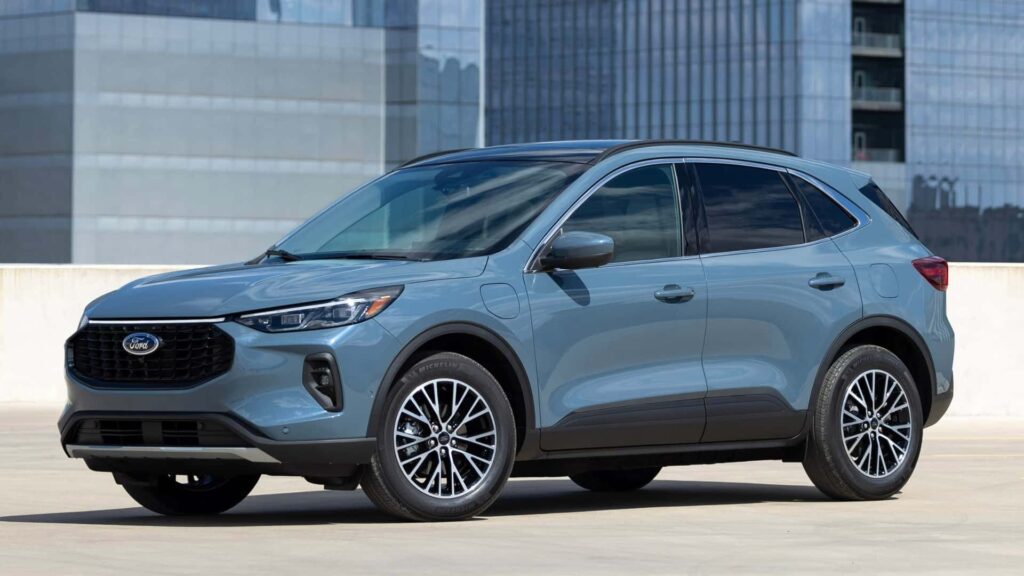
Trim Level Breakdown:
Ford has retained the same trim levels for the 2025 Ford Escape as in 2024, but with several changes:
– Active Trim: Now features black exterior accents instead of chrome and has a new Rapid Red tinted clearcoat color option. The power liftgate is now part of the optional 2025 Ford Escape Active Premium Package.
– ST-Line and ST-Line Select: The ST-Line trims have seen the removal of aluminum foot pedals and now feature molded-in black body cladding instead of body-colored finishes. Power liftgate availability varies by trim.
– ST-Line Elite and Platinum: These trims no longer feature leather seats; instead, they come with ActiveX-trimmed seats. The 360-degree camera has been moved to a package rather than being standard.
– Plug-In Hybrid: The plug-in model now features chrome around the windows and along the beltline, a change from last year’s partial chrome detailing. ActiveX seats replace leather in this trim as well.
Pricing and Savings
Despite reducing some features, the price drop across the board makes the 2025 Escape attractive. Depending on the trim, you could save between $1,500 to $2,200 compared to the 2024 model. However, it’s essential to consider the feature reductions before deciding.
Final Thoughts:
The 2025 Ford Escape offers a mix of changes that could make it appealing for those looking for a lower price point, even with some removed features. Ford has already made the build-and-price tool live on their website for those interested in ordering, and dealers are currently taking orders.
Be sure to carefully explore each trim level and feature package, especially if transitioning from a 2024 model. Stay tuned for in-depth videos breaking down the different trims and packages to help you decide which 2025 Ford Escape best suits your needs.
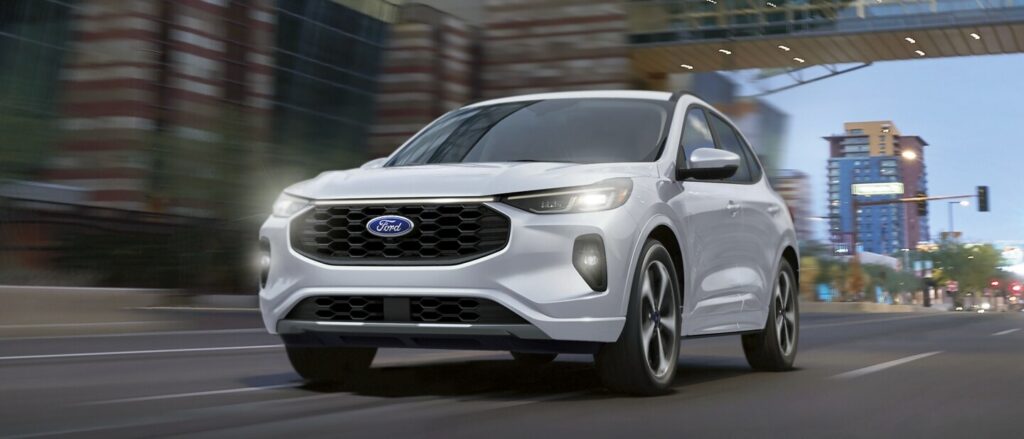
2025 Ford Escape Technology
From standard Ford Co-Pilot360 to wireless Apple CarPlay and Android Auto smartphone compatibility, 161 brings extraordinary technology to your daily getaways.
The 2025 Ford Escape rolls in with a whimper, not a bang. It’s a subtle entrance for a car that has been a staple in Ford’s lineup for years. We only saw the 2023 refresh yesterday, yet here we are again, looking at another iteration. Time flies when you’re keeping up with the auto industry. Ford’s playing it safe, opting for minor tweaks rather than a complete overhaul.
The engineers have focused on refining what already works rather than reinventing the wheel. But don’t be fooled by the familiar exterior; some things have changed. The subtle design updates might not be immediately noticeable, but they are there. Oh yes, things have changed.
The interior has seen some updates to enhance the driving experience. Ford’s up to its old tricks, tinkering under the hood and inside the cabin. They’ve made adjustments to the engine and added some new tech features. Frankly, some of these enhancements feel more like cost-cutting measures. For instance, the materials used in the interior have taken a step back in quality.
Don’t get me wrong—the Escape remains a decent car. It’s reliable, practical, and still offers a comfortable ride for families. But it’s not exactly setting the world on fire. In a market crowded with innovative options, the Escape feels like it’s playing catch-up.
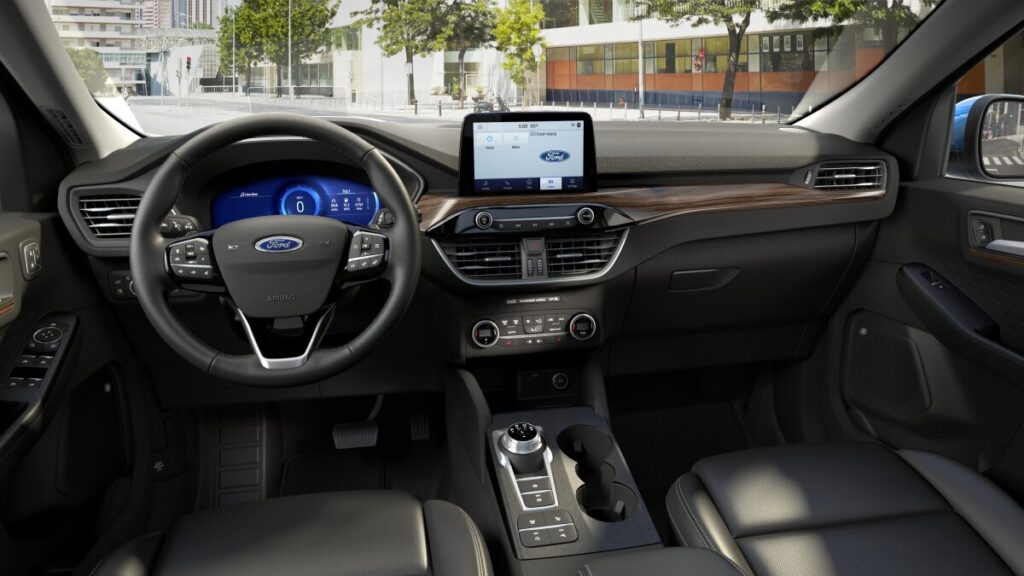
Let’s dive into the nitty-gritty, shall we? We’ll explore what’s new, what’s improved, and what might leave you wanting more.
The steering wheel is first on the chopping block, specifically the premium-wrapped steering wheel in the Active trim. Gone. Vanished. It was replaced with a standard pleather-clad monstrosity. I’m not one for excessive luxury, but something must be said about a good steering wheel.
It’s the primary point of contact between man and machine, and to have that tactile pleasure snatched away is—well, it’s criminal. Ford claims it’s to streamline the lineup. Streamline my foot—this is a blatant attempt to boost profits, plain and simple.
Speaking of streamlining, Ford’s also taken a hatchet to the trim levels. Once a bastion of affordable luxury, the SEL trim has been stripped bare. Power seats? Gone. Aluminum pedals? History. Ambient lighting? Say goodbye to those fancy mood lights.
It’s a similar story across the board: once-standard features are now optional extras. Ford’s nickel-and-diming us, squeezing every last penny out of its customers. It’s a sad state of affairs. The Escape used to be a good value proposition; now, it’s just another victim of corporate greed.
But it’s not all doom and gloom. There are still some bright spots to look forward to. Ford’s graced the Escape with a couple of new color options, adding a touch of flair to the lineup. For example, Space Silver Metallic sounds futuristic and looks even better in person. But hold your applause because they’ve also axed Iconic Silver Metallic, a fan favorite.
And here’s a real head-scratcher—the spare tire. Remember that? The trusty backup for emergencies, the thing you’d use if you got a flat tire? Yeah, that’s gone too. Imagine being stranded without it, replaced with a measly inflator kit. Not exactly reassuring. Spare tires are so last year. Ford seems to think we won’t miss them—never mind that inflator kits are useless for anything other than a minor puncture. No, Ford knows best. Or do they?
With all these deletions, the price would go down. Wrong. The 2025 Ford Escape is more expensive than the outgoing model. It’s a classic case of shrinkflation—you’re getting fewer cars for more money. It’s enough to make you want to pull your hair out. At least you’ll be able to drown your sorrows with the money you saved by not opting for the premium-wrapped steering wheel.
The journey of the Ford Escape is far from over. Despite the feature deletions, it still manages to hold its ground. It remains a decent crossover, offering a comfortable ride and a spacious interior that families will appreciate. The interior is designed to provide ample space, making long journeys more enjoyable. But it’s hard not to feel a sense of disappointment.
The potential for greatness was there. Ford had an opportunity to elevate the Escape to make it a standout in the crowded crossover market. Instead, it feels like Ford played it safe and, in doing so, missed the chance to make the Escape a true contender.
Overview Ford Escape 2025
This Escape is new but goes back two decades or so. The Escape helped launch the compact crossover from being a weird sedan alternative to the ubiquitous vehicles we have now. There’s a good reason: compact crossovers like the Escape offer this particular Goldilocks combination of practicality, capability, and affordability that is absolute catnip for Millennials. And I should know because I’m a Millennial.
You can buy a new or used Ford Escape right now, so if you’re looking for a bargain, head to CarGurus.com, where we can help you find suitable and great deals. The Escape used to be a boxy little guy, but Ford swapped in a much more European design during the third generation, and it continues with this fourth-generation model.
Before 2023, the third-gen had a happier face, like a smiling goldfish, but now this new grille with the center-mounted Ford emblem looks much tougher—more in line with today’s style. Compared with cars like the Honda CR-V, Toyota RAV4, or even the Escape’s Ford sibling, the Bronco Sport, this looks much more amorphous.
The Escape looks more upscale than those competitors. We are testing an ST-Line Elite trim, complete with 19-inch rims, body-color mirrors, wheel cladding, and this cool LED light bar spanning the top of the grille. At the rear, Escape is spelled out in wide-set letters between two handsome taillights.
And at the bottom, we’ve got dual exhaust outlets. The Escape is more blocky and rugged-looking than some of the other crossovers in its class, but it has its level of sophistication. It’s more on the Mazda-meets-Mercedes styling track.
Inside, this Escape is more style than substance. I love the look of this quilted leather upholstery, and the red contrast stitching in this car looks relaxed. Given that it’s a compact crossover, it adds a little flair. But if I’m honest, the quality of the leather does seem to be lacking a little bit—it’s got too much of that stiff, plasticky feel. It will probably hold up pretty well, but I don’t think it will age well; high-quality leather does.
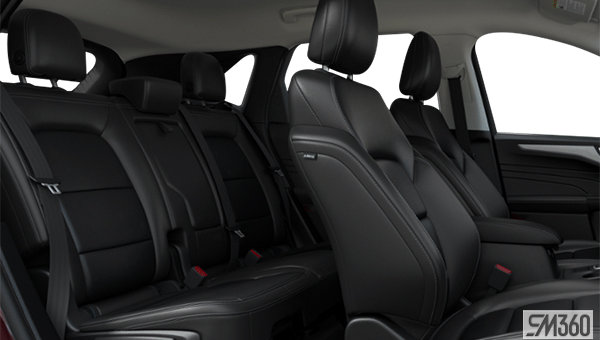
Furthermore, where there’s no rugged leather, there’s hard plastic. Ford does a decent job disguising it, but it’s plastic nonetheless and doesn’t feel well-supported. Look at how this center console flexes—I don’t want to see that.
Now, admittedly, this is a comfortable SUV. The seats are well-cushioned, they don’t feel restrictive, and I could dial in a near-perfect seating position with the driver’s seat’s 10-way adjustments. The center console armrest position is solid, the cupholders are well-placed, and the steering wheel feels good, even if it looks drab. The back seat also offers plenty of space -40.7 inches. Plus, the seatbacks are deeply scalloped and softly padded, in case you must give Victor Wanyama a lift home.
The trunk is a bit tighter, with up to 37.5 cubic feet of space behind the rear seat—65.4 with it folded. You’ll usually be fine, but coming from something like a Honda CR-V or a Nissan Rogue might feel a little snug on moving day.
Ford sells the Escape with a few different engine options. Those are respectable numbers for a three-cylinder, but we’re working with something else today. Instead, we have a 2.0L turbocharged four-cylinder that turns out 250 horsepower and 280 lb-ft of torque. While the smaller engine can be equipped with all-wheel drive, the larger 2.0L is all-wheel drive only.
280 lb-ft of torque is a lot of giddy-up for a compact crossover, but the Escape never feels like a performance crossover. For instance, the 8-speed automatic transmission does a great job of managing the gears, but there are no paddle shifters, and you can’t shift between those gears because this is a rotary controller, not a genuine shifter. Similarly, despite having a sport driving mode, the Escape always feels slightly soft. The brakes are solid, but the steering is vague.
This is a comfortable crossover—it leans through the corners and soaks up the uneven pavement. This 2.0L engine offers a lot of extra power and will help with overtakes or on-ramps, but it doesn’t turn the Escape into a corner carver. It’s more about power than performance.
With the three-cylinder engine and front-wheel drive, you can expect 27 MPG in the city, 34 on the highway, and 30 combined. Those numbers will drop slightly if you add all-wheel drive, and if you get the 2.0L with all-wheel drive, expect 23 MPG city, 31 highway, and 26 combined.
I’ve been seeing over 385 miles here—it’s showing 27.6 MPG, so that’s pretty good. But suppose your top priority is fuel economy. In that case, I recommend looking at the Escape Hybrid, which can do 39 in combined driving, or the Escape Plug-in Hybrid, which will drive 37 miles on electricity alone before its hybrid engine will deliver 40 MPG.
Ford’s tech efforts have significantly improved over the last ten years, interrupted by some fits and starts. The company has hit its stride with SYNC 4 running in the Escape. First, this 13.2-inch display looks terrific—it immediately upgrades the cabin with its big, widescreen display.
The user interface is easy, simple, and stylish. I love the bucketed icons—you’ve got them for maps, music, and phones, and all the details are well thought out. Case in point: a dedicated home button sits at the top of the screen, even if you’re in Android Auto, and this rightmost panel will show you what’s playing on satellite radio, again, even if you’re in Android Auto.
Our test car has wireless Apple CarPlay, Android Auto, and a wireless charging pad. There are a few annoyances: for one, the wireless Android Auto connection seems to draw more power from my phone than the wireless charging pad can replenish, so eventually, I’ll end up with a zero battery if I drive long enough. I also don’t love that the HVAC controls are on the screen.
They’re laid out, but I’d prefer those to be physical buttons. I don’t love that the volume knob is over here, making room for the engine start/stop button under here, and it’s not always the fastest system to respond. That said, it is undoubtedly easy to use, it looks great, and I haven’t encountered any significant bugs or frustrations.
In terms of safety, the NHTSA awarded the 2024 Ford Escape five out of five stars in its overall crashworthiness test, and while the IIHS did give the 2023 model a somewhat worrisome rating of marginal in its side-impact crash test, it nonetheless got the top rating of “good” in all other tests. Ford also packages Co-Pilot 360 as standard equipment on every Escape.
Automatic emergency braking. All of that sounds good. You can upgrade the Escape further with adaptive cruise control, road sign recognition, lane centering, and a 360-degree camera. While lane-keeping can be slightly inconsistent, the overall suite is undeniably impressive.
The 2024 Ford Escape will start at $28,840, including a $1,495 destination fee for the base Active trim. To put that into perspective, a base-trim Chevy Equinox won’t cost you more than $28,000, and a base Hyundai Tucson no more than $29,000. But on the other hand, you can’t get into a Mazda CX-5 for less than $30,000, so that puts the base trim levels of the Escape somewhere in the upper middle of the pack.
This ST-Line Elite trim we tested today costs almost $43,000, which means you’re paying a steep premium for this one. But you are getting the upgraded engine, the upgraded tech, and the upgraded safety. So, is it worth it? Well, that depends on how much you value those features.
Outside of its engine, which does outgun most of the competition, the Escape fails to outshine much of the field in any specific area. Now, don’t get me wrong—Ford still sells a ton of Escapes, but seeing as there is a lot more competition from rapidly improving crossovers across the marketplace, and even just the existence of the Ford Bronco Sport, well, it’s easy for the Escape to get a little lost in the shuffle. And that’s too bad because the Escape has been with us.
2025 Ford Escape colors
Ford Escape has many colors like Pearl, Metallic Grey, Red, Black, and Silver Metallic also.

